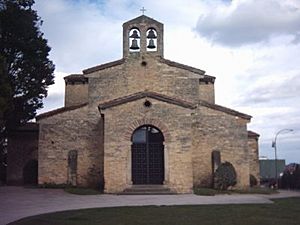Tioda facts for kids

Tioda was a very important Asturian architect who lived in the 800s. He worked mostly in a city called Oviedo, in a region of Spain known as Asturias. Tioda designed many famous buildings, including a big church that later became a cathedral (a main church for a bishop) and a Royal Palace for the kings.
The kings Alfonso II of Asturias and Ramiro I of Asturias thought Tioda's work was excellent. They paid him to design even more buildings. Around the year 830, King Alfonso II asked Tioda to rebuild the San Julián de los Prados church. This church is now seen as one of the greatest examples of Asturian art and Asturian architecture. Because of its importance, the Spanish government declared it a special historical monument in 1917. Later, in 1998, UNESCO named it a World Heritage Site, meaning it's important for everyone in the world to protect.
Some people have called Tioda Spain's first "urbanist." An urbanist is someone who plans how cities are built and organized. Because his name was a bit unusual, some historians have wondered if he might have originally come from a city called Aachen.
Contents
Famous Buildings by Tioda
Tioda was known for designing several key buildings in Oviedo. These structures were very important for the Asturian kingdom at the time.
The Cathedral of San Salvador
One of Tioda's most famous projects was the church of San Salvador. This church was so grand that it later became the main cathedral for the Roman Catholic Diocese of Oviedo. Cathedrals are usually very large and important churches where a bishop leads religious services.
The Royal Palace
Tioda also designed the Royal Palace in Oviedo. This was the home and official building for the kings of Asturias. It was a central place for the government and where important decisions were made.
San Julián de los Prados: A Special Church
The church of San Julián de los Prados is a fantastic example of Tioda's skill. King Alfonso II asked Tioda to rebuild it, and it became a masterpiece of early Asturian architecture.
A World Heritage Site
This church is so special that it has been recognized globally. In 1917, it was named a Historical-Artistic Monument by the Spanish government. Even more importantly, in 1998, UNESCO declared it a World Heritage Site. This means it's considered a place of outstanding universal value that should be preserved for future generations.
See also
 In Spanish: Tioda para niños
In Spanish: Tioda para niños

